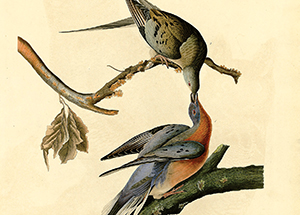Requiem for a Silenced Species
Caged in a glass display on Hillman Library’s ground floor is a life-sized engraved color print of two passenger pigeons, graceful in their ballet-like pose. The print, created from an 1824 painting by ornithologist John James Audubon, is believed to be the only bird painting that Audubon did in Pittsburgh.
in a glass display on Hillman Library’s ground floor is a life-sized engraved color print of two passenger pigeons, graceful in their ballet-like pose. The print, created from an 1824 painting by ornithologist John James Audubon, is believed to be the only bird painting that Audubon did in Pittsburgh.
The library’s Special Collections Department selected this print—part of its biweekly Audubon display—to honor a bird named “Martha,” the world’s last surviving passenger pigeon, which died 100 years ago this month, on Sept. 1, 1914, in captivity at Ohio’s Cincinnati Zoological Gardens. She lived alone in her cage for all 29 years of her life. Upon her death, Martha’s body was packed in a 300-pound block of ice and sent to the Smithsonian Natural Museum of History, where the museum’s taxidermist preserved her for posterity. Her feathers and form are currently displayed in an exhibition about extinct birds.
Once one of the world’s most abundant species—numbering 3 to 5 billion—passenger pigeons met a cruel fate during the 19th century because of overhunting and habitat loss. The last confirmed sighting of the bird in the wild was in 1900, according to the Smithsonian National Museum of Natural History’s website. But in their heyday, the species was famous for taking flight in flocks so huge they would blacken the sky.
Audubon observed such a sight in 1813 as he traveled on horseback to Louisville, Ky. The mass of flying birds continued unabated for three days. “The air was literally filled with Pigeons; the light of noon-day was obscured as by an eclipse …,” Audubon wrote in his Ornithological Biography, the companion piece to his famous Birds of America engravings.
While overall a depressing tale for both the species and Martha, at least the lone female survivor ended up receiving some pampering—albeit posthumously. Martha has remained on display in various exhibitions at the Smithsonian, leaving only twice: once to travel to a San Diego conservation conference and once to return to the Cincinnati Zoological Gardens, which dedicated a building in her name. “Both times,” the Smithsonian’s website says, “she was flown first class, with an airline flight attendant escorting her for the entire trip.”
Thankfully, Pitt faculty, staff, and students don’t need to book a flight to see the extinct species for themselves; Hillman’s own Audubon prints preserve a small piece of the past for the University community.
Other Stories From This Issue
On the Freedom Road

Follow a group of Pitt students on the Returning to the Roots of Civil Rights bus tour, a nine-day, 2,300-mile journey crisscrossing five states.
Day 1: The Awakening
Day 2: Deep Impressions
Day 3: Music, Montgomery, and More
Day 4: Looking Back, Looking Forward
Day 5: Learning to Remember
Day 6: The Mountaintop
Day 7: Slavery and Beyond
Day 8: Lessons to Bring Home
Day 9: Final Lessons

